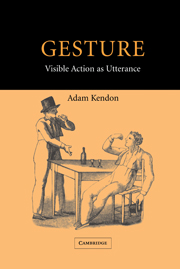Book contents
- Frontmatter
- Contents
- Acknowledgments
- 1 The domain of gesture
- 2 Visible action as gesture
- 3 Western interest in gesture from Classical Antiquity to the eighteenth century
- 4 Four contributions from the nineteenth century: Andrea de Jorio, Edward Tylor, Garrick Mallery and Wilhelm Wundt
- 5 Gesture studies in the twentieth century: recession and return
- 6 Classifying gestures
- 7 Gesture units, gesture phrases and speech
- 8 Deployments of gesture in the utterance
- 9 Gesture and speech in semantic interaction
- 10 Gesture and referential meaning
- 11 On pointing
- 12 Gestures of ‘precision grip’: topic, comment and question markers
- 13 Two gesture families of the open hand
- 14 Gesture without speech: the emergence of kinesic codes
- 15 ‘Gesture’ and ‘sign’ on common ground
- 16 Gesture, culture and the communication economy
- 17 The status of gesture
- Appendix I Transcription conventions
- Appendix II The recordings
- References
- Index
Appendix I - Transcription conventions
Published online by Cambridge University Press: 05 February 2015
- Frontmatter
- Contents
- Acknowledgments
- 1 The domain of gesture
- 2 Visible action as gesture
- 3 Western interest in gesture from Classical Antiquity to the eighteenth century
- 4 Four contributions from the nineteenth century: Andrea de Jorio, Edward Tylor, Garrick Mallery and Wilhelm Wundt
- 5 Gesture studies in the twentieth century: recession and return
- 6 Classifying gestures
- 7 Gesture units, gesture phrases and speech
- 8 Deployments of gesture in the utterance
- 9 Gesture and speech in semantic interaction
- 10 Gesture and referential meaning
- 11 On pointing
- 12 Gestures of ‘precision grip’: topic, comment and question markers
- 13 Two gesture families of the open hand
- 14 Gesture without speech: the emergence of kinesic codes
- 15 ‘Gesture’ and ‘sign’ on common ground
- 16 Gesture, culture and the communication economy
- 17 The status of gesture
- Appendix I Transcription conventions
- Appendix II The recordings
- References
- Index
Summary
The transcriptions used as part of the descriptions of the examples given throughout the book are meant to contain just enough information to make the explanations of the examples clear. For speech, we have used standard orthography. For the transcription of gesture we have followed a highly simplified method which, we hope, is immediately readable, showing in the transcriptions only those aspects of gestural action that are directly pertinent for the account being offered. Other gestures in the examples are often not shown, therefore, and interesting and important aspects such as postural changes, bodily and facial orientation and direction of gaze are indicated in the transcripts only if they are relevant to the immediate purpose for which the example is being used. To follow any other practice we felt would overload the transcriptions to the point that most readers would find it too much work to follow them.
The following conventions have been used in most of the transcripts. When there are particular features of an example that need to be brought out, conventions not listed here may have been followed. In these exceptional cases the conventions are explained in a key accompanying the transcription.
Speech is transcribed using conventional orthography. Tone unit boundaries are shown by /. Where tone units are numbered a number in round brackets is placed above the line of text at the beginning of the tone unit.
- Type
- Chapter
- Information
- GestureVisible Action as Utterance, pp. 362 - 364Publisher: Cambridge University PressPrint publication year: 2004

